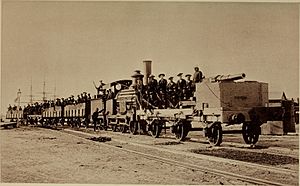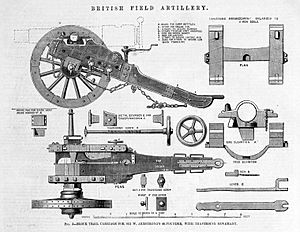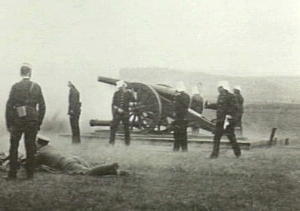RBL 40-pounder Armstrong gun facts for kids
Quick facts for kids RBL 40-pounder gun |
|
|---|---|

Diagram from 'Treatise on Service Ordnance' (HMSO), 1877
|
|
| Type | Naval gun Fortification gun |
| Place of origin | United Kingdom |
| Service history | |
| In service | 1860s – 1900? |
| Used by | United Kingdom Australian colonies |
| Wars | New Zealand Wars Bombardment of Kagoshima |
| Production history | |
| Designer | W.G. Armstrong Co. |
| Manufacturer | W.G. Armstrong Co. Royal Gun Factory |
| Produced | 1859 – 1863 |
| No. built | 1013 |
| Variants | 32cwt, 35cwt |
| Specifications | |
| Mass | 32 cwt (3,584 pounds (1,626 kg)), later 35 cwt (3,920 pounds (1,780 kg)) gun & breech |
| Barrel length | 106.3 inches (2.700 m) bore & chamber |
|
|
|
| Shell | 40 pounds 2 ounces (18.20 kg) |
| Calibre | 4.75-inch (120.6 mm) |
| Breech | Armstrong screw with vertical sliding vent-piece (block) |
| Muzzle velocity | 1,180 feet per second (360 m/s) |
The Armstrong RBL 40-pounder gun was a powerful cannon first used in 1860. It could be used on both land and sea. This gun was special because it used a new and clever design by William Armstrong. It was a breech-loading gun, meaning it was loaded from the back, not the front. It also had a rifled barrel, which made its shots more accurate. This gun was used for many years, until about 1902, when newer, more modern guns took its place.
Contents
How the Gun Was Designed
The Armstrong screw breech was a new way to load guns from the back. It had worked well for smaller guns, like the RBL 12 pounder 8 cwt field gun. Even though William Armstrong thought this design might not be strong enough for very heavy guns, the British Government wanted it used for bigger cannons too. These guns were made in two main places: the Royal Gun Factory in Woolwich and the Elswick Ordnance Company.
Like other early Armstrong guns, they had special grooves inside the barrel called "rifling." This made the cannonballs spin as they flew, helping them go straighter and farther. The cannonballs were often covered in lead.
Different Types of the Gun
The first version of the 40-pounder gun weighed 32 cwt (hundredweight). A cwt is about 112 pounds, so 32 cwt is around 3,584 pounds! Later, a stronger version was made that weighed 35 cwt (about 3,920 pounds). This new version had a longer and tougher part at the back where it was loaded.
In 1864, another type of 32 cwt gun was made. This one had a different way of loading, using a "sliding-wedge" instead of the Armstrong screw. This was an attempt to fix some problems people thought the screw-breech design had. However, this wedge version was taken out of service by 1877.
Around 1880, a few of the 35 cwt guns were changed so that their loading part opened to the side instead of up and down. These were called "side-closing" guns. They were still locked by tightening a screw behind the loading block.
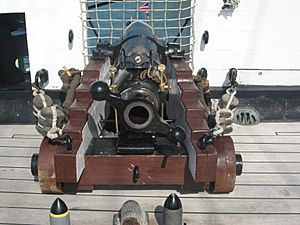
In 1859, the Navy decided this gun would be good for their ships. It could be used as a broadside gun (meaning it fired from the side of the ship) or a pivot gun (which could turn to aim in different directions).
An officer from HMS Euryalus wrote about how well the gun worked during the Bombardment of Kagoshima in August 1863. He said the 40-pounder was "exceedingly well" and could hit targets very accurately from far away, even 3,800 yards (over 2 miles!). He mentioned that a few parts broke, but they were quickly replaced, and the gun was easy to use.
Later, during the Anglo-Egyptian War in 1882, a 40-pounder RBL gun was put on an armored train. Sailors from the Royal Navy operated it. This gun even saw some action in a battle called Kassasin on September 1, 1882.
Used on Land
These guns could be placed on different types of carriages for use on land. Some had wooden wheels and could be pulled by teams of strong horses. This made them somewhat mobile for sieges (when an army surrounds a fort or city).
For guns placed inside forts, there were two main types of carriages. One was an iron carriage that allowed the gun to turn left and right. It also helped absorb the kickback (recoil) when the gun fired. Other guns in forts were put on tall "siege travelling carriages." These allowed the guns to fire over the fort's walls.
Many 40-pounder guns were given to volunteer artillery groups starting in 1889. These groups were made up of regular citizens who trained to help defend their country. By 1893, there were thirty such groups in England equipped with 40-pounder guns. They were meant to gather in Surrey and Essex if there was a need to defend the country. These guns were used until 1902, when they were slowly replaced by newer, faster-firing guns. Some 40-pounders were kept for many years after that, just for firing salutes (like at ceremonies).
In the Indian Subcontinent
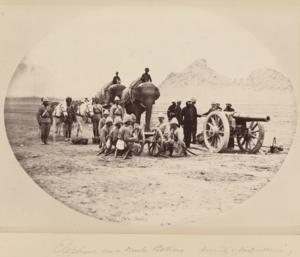
A photograph from the Second Anglo-Afghan War (1878–1880) seems to show an RBL 40-pounder Armstrong gun. This war happened because Great Britain was worried about Russia's growing influence in Afghanistan. The war had two parts, and it ended in 1880.
In the Colony of Victoria (Australia)
The Australian colony of Victoria received six 35 cwt guns in August 1865. They were used to defend the coast. One gun was even put on a ship called Victoria for a couple of years. Later, four of these guns were used as field guns (meaning they could be moved around) in a place called Hastings. Today, three of these guns still exist.
In the Colony of Tasmania (Australia)
After reports in 1877 about how to defend the Australian colonies, the Launceston Volunteer Artillery Corps in Tasmania got two of these guns. They had newer iron carriages with iron wheels. This group continued to use these guns until at least 1902.
Where You Can See Them Now
Many RBL 40-pounder guns still exist today in different parts of the world. Here are some places where you can find them:
- A gun made in 1865 by the Royal Gun Factory is at Elizabeth Castle, Jersey.
- Three guns that were once used as bollards (posts for tying up boats) were found at Broughty Castle, Dundee, Scotland.
- Restored gun No. 272 is at the Hastings-Western Port Historical Society Museum in Victoria, Australia.
- Restored Gun No. 271 is at Fort Queenscliff, Victoria, Australia.
- Unrestored Gun No. 268 is in Como Park, South Yarra, Victoria.
- A gun is at Fort Henry, Canada.
- Preserved gun No. 419 G from 1867 is at the Canadian War Museum, Ottawa, Canada.
- There is one at the Royal Canadian Artillery Museum, Manitoba, Canada.
- A 40-pounder side-closing gun made by Elswick Ordnance Company is at Royal Armouries, Fort Nelson, Portsmouth.
- At Fort St. Catherine's, Bermuda. This is one of eight guns sent to Bermuda. They were meant to be mobile guns, stored and moved as needed to different old forts. Some of these were later used for firing salutes.
- At the Royal Naval Dockyard, Bermuda (two guns). One was found at Bailey's Bay Battery and is now restored and on display at the National Museum of Bermuda. Another was used as a bollard at Red Barracks and has also been moved to the museum.
- At Penno's Wharf, St. George's Town, Bermuda. Two guns were used as bollards here. They have been restored and are now outside the World Heritage Centre.
- On board HMS Warrior, Portsmouth, UK.
See also
- List of naval guns
- Armstrong gun



